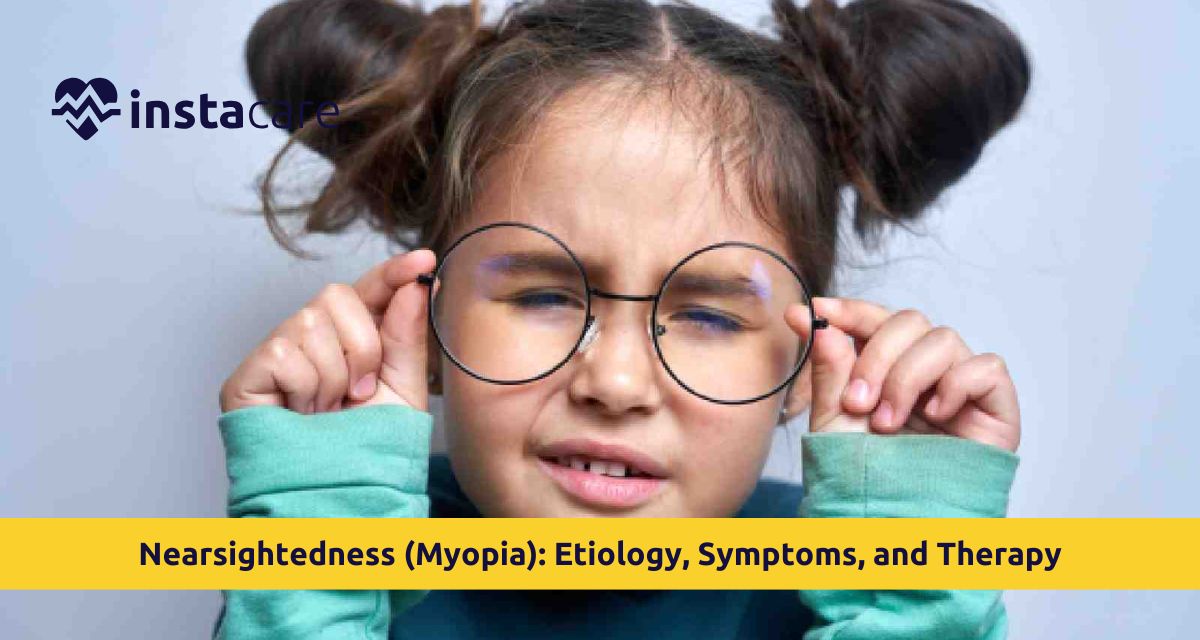This book explains what nearsightedness is, how it may be diagnosed, and how it may be treated from nearsightedness glasses to nearsightedness laser surgery and grapples with advice on how to cope with or even prevent its decline.
What is Nearsightedness (Myopia)?
Myopia is an abnormality of refraction where far-away objects cannot be seen but near objects can be seen. This results from the eyeball becoming longer or the cornea being more steep than usual so that light to the eye converges before the retina instead of on the retina.
These results in poor distance vision and simple daily activities such as driving, watching television, or seeing faces at a distance are a problem. Nearsightedness is not typically harmful when a child has it, but progressive myopia has a tendency to cause accelerated eye disease as an adult.
Causes and Risk Factors of Nearsightedness
Most Common Reasons for Myopia are:
- Genetics: Either both parents being nearsighted, or even one parent, increases the risk in the child
- Insufficient outdoor exposure: It has been proven through research that those who have less exposure to the world outside are prone to myopia in the future
- Extended near work or screen: Extended near work leads to fatigued eyes, which in turn lead to myopia
- Insufficient light: Working or reading in dim lights may lead to extended tired eyes
Other Myopia Risk Factors Leading to Myopia in the Individual:
- Premature birth
- Ethnicity (eastern Asian ethnic groups have higher incidence)
- Increased duration of education (relationship to degree level and length of employment)
Nearsightedness Symptoms and Signs
Prevention of future myopia complications in children through early detection of nearsightedness.
Usually Presents As:
- Blurred distance vision
- Squinting in a futile effort to view clear objects
- Eye strain leading to a chronic headache
- Eye strain during reading or on use of computers
- Difficulty reading the whiteboard or monitor in school (with nearsightedness in children)
If you or your child experience these nearsightedness symptoms, have an eye specialist conduct a
test of eyesight.
Diagnosis of Myopia
Nearsightedness diagnosis is usually easy. Ophthalmologists give a thorough eye examination that includes:
- Visual acuity test: Reading at different distances off an eye chart
- Refraction test: Finding the most becoming lens prescription with a chiropter
- Retinal test: Examining the inner eye
Routine eye check-up is a necessity, especially in kids, since progressive myopia can advance quite quickly with school years.
Myopia Treatment
There are numerous procedures for nearsightedness treatment depending on the degree of severity and patient requirements on a daily basis.
1. Eyeglasses for Nearsightedness
The majority of conventional and non-surgical type is concave lenses of nearsightedness glasses that bend light onto the retina for better vision at far.
2. Contact Lenses
For individuals with active prescriptions, contact lenses bother other people less and offer more peripheral vision than nearsightedness glasses do.
3. Laser Eye Surgery (LASIK/PRK)
Nearsightedness laser surgery bends the cornea to enable light to focus normally on the retina. It's best for adults with stable prescriptions.
4. Orthokeratology (Ortho-K)
Nighttime special contact lenses reshape the cornea briefly to correct nearsightedness during the day.
5. Myopia Control Lenses
These are specially prescribed myopia control lenses or glasses that, other than correcting the eye, slow down myopia progression — what a nuisance for nearsightedness in children.
6. Prescription Eye Drops
Diluted concentrations of atropine combined with eye drops have slowed the progression of advancing myopia in children, although to date they have not been tried anywhere else on the planet.
Can Myopia Be Prevented or Controlled?
Although you cannot prevent myopia from occurring, some myopia prevention tips will slow the development or postpone its occurrence:
Prevention Tips:
- Take kids outside for a minimum of 1–2 hours daily
- Lessen screen usage and view devices with correct posture
- Follow the 20-20-20 rule: Glance away from something 20 feet in front of you for 20 seconds every 20 minutes
- Employ adequate illumination while studying or working
- Regular check-up of eyes as follow up visit, particularly nearsightedness in children
These simple habits will yield big payback, particularly if one starts early.
Long-term Complications of High Myopia
Although myopia is simple to correct if mild, progressive myopia or high myopia can have severe myopia complications:
- Serious Complications Include:
- Retinal detachment
- Cataract at earlier age
- Glaucoma
- Myopic macular degeneration
The complications emphasize myopia correction and long-term care also, particularly in high refractive error patients.
Living with Myopia
Myopia is manageable, and millions of people have normal lives with corrective eye glasses or surgery. The best methods of controlling the condition are:
Management Strategies:
- Dressing in corrective eye glasses daily
- Filling prescriptions regularly
- Nearsightedness eye exercises like rolling the eyes, blinking, and palming to minimize tension from the eyes (though these will not remove myopia, they will remove pain)
- Eye health check-ups regularly
- Demand for new treatments such as myopia control lenses in children or nearsightedness laser surgery in adults
Conclusion
Myopia, commonly referred to as nearsightedness, is a universal affliction with very high prevalence rates in children. While often regarded as a harmless nuisance, in its untreated state, it is harmful and becomes severe eye issues. In a positive sense, nonetheless, because of early nearsightedness treatment, proper management, and lifestyle adjustments, myopia can be managed.
Whichever one you are thinking of, nearsightedness glasses, contact lenses, or nearsightedness laser surgery, the correct nearsightedness treatment will be based on your age, your needs for vision, and the condition of your eye. Discuss with your eye care professional what is right for you or your child.
Please book an appointment with the
Best Eye Specialist in Lahore, Karachi, Islamabad, and all major cities of Pakistan through
InstaCare, or call our helpline at 03171777509 to find the verified doctor for your disease.

